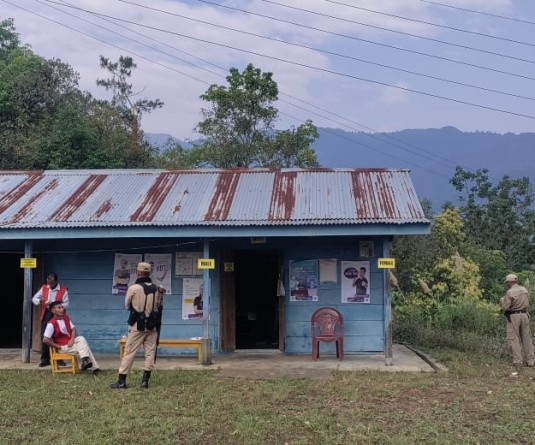
DIMAPUR, SEPTEMBER 16 (MExN): The Department of Health and Family Welfare has informed that it had received a message through telephone on 12th September 2011 of an outbreak of fever of unknown cause leading to three deaths at Poilwa village, Peren District. Immediately the State Rapid Response Team (RRT) of Integrated Disease Surveillance Project (IDSP), Nagaland, comprising of Dr. John Kemp (State Surveillance Officer), Dr. Sao Tunyi (Epidemiologist), Dr. Kevisevolie Sekhose (Epidemiologist), and Venezo Vasa (Entomologist) conducted an outbreak investigation at Poilwa village.
The team collected three samples from suspected cases out of which all the three were tested positive for Scrub Typhus. Till date, there are 9 cases with 3 deaths. This was stated in a official press note issued by Dr. Imtimeren Jamir, the Principal Director, Directorate of Health & Family Welfare, Kohima. Scrub Typhus is Rickettsial disease caused Orientia tsutsugamushi and transmitted by the bite of mite called Leptotrombidium deliense. In Nagaland, it was formerly detected by IDSP with Central Surveillance Team at Longsa village Mokokchung in 2006, and in Porba village of Phek District in 2007.
The team collected three samples from suspected cases out of which all the three were tested positive for Scrub Typhus. Till date, there are 9 cases with 3 deaths. This was stated in a official press note issued by Dr. Imtimeren Jamir, the Principal Director, Directorate of Health & Family Welfare, Kohima. Scrub Typhus is Rickettsial disease caused Orientia tsutsugamushi and transmitted by the bite of mite called Leptotrombidium deliense. In Nagaland, it was formerly detected by IDSP with Central Surveillance Team at Longsa village Mokokchung in 2006, and in Porba village of Phek District in 2007.
Signs and Symptoms
• After bite by infected mite larvae called chiggers, papule develops at the biting site which ulcerates and eventually heals with the development of a black eschar.
• Patients develop sudden fever with headache, weakness, myalgia, generalized enlargement of lymph nodes, photophobia, and dry cough.
• A week later, rash appears on the trunk, then on the extremities, and turns pale within a few days.
• Symptoms generally disappear after two weeks even without treatment.
• However, in severe cases with Pneumonia and Myocarditis, mortality may reach 30%.
Diagnosis
• The most commonly used test for diagnosis is Wel-Felix Test, which is available at State IDSP laboratory, Kohima.
• More specific serological tests like detection of IgM can also be done for diagnosis.
• IFA is the gold standard.
Treatment
• Scrub Typhus responds well to antibiotic Doxycycline or Chloramphenicol.
• In resistant cases, Rifampicin can be used.
• In children and pregnant women, Azithromycin is the drug of choice.
• Sulfonamide group of drugs are contraindicated.
Preventive measures
• As Scrub Typhus is found in distinct areas (Typhus Island), control measures can be carried out by treating the ground and vegetation with residual insecticides, reducing rodent populations, and destroying limited amounts of local vegetation.
• Protective clothing, applying of mite repellent to exposed skin, and chemoprophylaxis can be considered for persons in infested terrains.
• No effective vaccine has been developed till date.
The State RRT team carried out the outbreak investigation along with doing and entomological survey. The patients were treated with appropriate medicines and awareness and preventive measures were communicated with the villagers. The concerned local health authorities and programs are informed for further necessary action. The mop-up operation is being carried out by the National Vector Borne Disease Control Program.
• After bite by infected mite larvae called chiggers, papule develops at the biting site which ulcerates and eventually heals with the development of a black eschar.
• Patients develop sudden fever with headache, weakness, myalgia, generalized enlargement of lymph nodes, photophobia, and dry cough.
• A week later, rash appears on the trunk, then on the extremities, and turns pale within a few days.
• Symptoms generally disappear after two weeks even without treatment.
• However, in severe cases with Pneumonia and Myocarditis, mortality may reach 30%.
Diagnosis
• The most commonly used test for diagnosis is Wel-Felix Test, which is available at State IDSP laboratory, Kohima.
• More specific serological tests like detection of IgM can also be done for diagnosis.
• IFA is the gold standard.
Treatment
• Scrub Typhus responds well to antibiotic Doxycycline or Chloramphenicol.
• In resistant cases, Rifampicin can be used.
• In children and pregnant women, Azithromycin is the drug of choice.
• Sulfonamide group of drugs are contraindicated.
Preventive measures
• As Scrub Typhus is found in distinct areas (Typhus Island), control measures can be carried out by treating the ground and vegetation with residual insecticides, reducing rodent populations, and destroying limited amounts of local vegetation.
• Protective clothing, applying of mite repellent to exposed skin, and chemoprophylaxis can be considered for persons in infested terrains.
• No effective vaccine has been developed till date.
The State RRT team carried out the outbreak investigation along with doing and entomological survey. The patients were treated with appropriate medicines and awareness and preventive measures were communicated with the villagers. The concerned local health authorities and programs are informed for further necessary action. The mop-up operation is being carried out by the National Vector Borne Disease Control Program.




